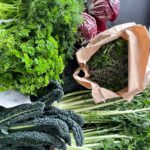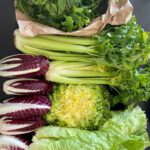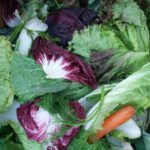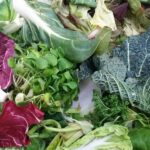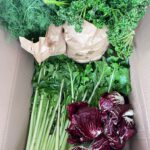Explanation:

Freely edible without restrictions, but make sure that at least two-thirds, preferably more, of the food consists of leafy greens! Additionally, other food sources (fresh herbs, branches, meadow plants…) should be included in the mix, for example:
- About 50% bitter salads (preferably 70% for indoor housing)
- About 30% leafy cabbage (preferably 10% for indoor housing)
- 15% other leafy vegetables and vegetable greens
- A maximum of 10% culinary herbs

Read the note beforehand!

Rather unsuitable as food, toxic or problematic, in some cases suitable in small amounts.
Information on rabbit nutrition

Artichoke
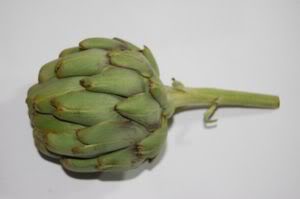
Canned artichokes are not suitable for feeding, as they are preserved in oil. Fresh artichokes can be offered in small amounts, but they are not really considered proper rabbit food.
Acceptance: poor
Calcium-Phosphorus ratio: 0.4

Eggplant
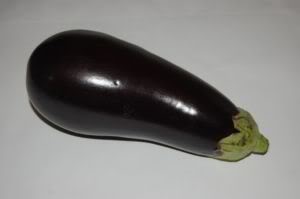
Eggplants can be offered occasionally in small amounts. Unripe parts and the green parts contain a relatively high solanine content and should only be fed in small quantities, mixed with other vegetables. Eggplants should be fed rarely.
Acceptance: poor
Calcium-Phosphorus ratio: 0.6

Avocado
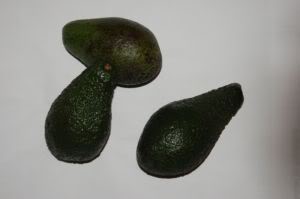
Unripe avocados can be toxic to rabbits. There have been some poisoning cases in the past linked to avocados, where persin, which can be toxic in large amounts, was blamed. However, persin is only present in toxic amounts in the leaves and pit. These poisoning cases are most likely due to pesticides or sprays, so it is better to avoid feeding avocado to rabbits as a precaution.
Acceptance: poor
Calcium-Phosphorus ratio: 0.3

Bamboo
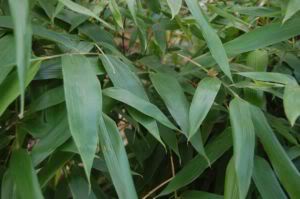
Garden bamboo is an ideal food as it remains green even in winter. It belongs to the grass family and is very suitable for feeding. Anyone who has the opportunity should consider planting this decorative plant. Bamboo is low in energy and therefore ideal for overweight rabbits.
Acceptance: very good
Warning! There is a risk of confusion with lucky bamboo, which is sold as a decorative table plant/houseplant and is not true bamboo. Lucky bamboo is toxic. Garden bamboo, regardless of the species, is suitable.

Batavia lettuce
Batavia lettuce can be safely fed to rabbits. The outer leaves are usually contaminated with pesticides and fertilizers, so it’s best to remove them before feeding.
Acceptance: good
Calcium-Phosphorus ratio: 0.9

Leaf spinach
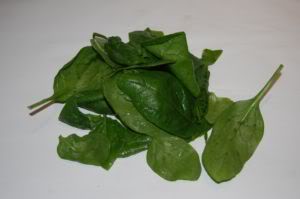
Leaf spinach is a leafy, popular food for rabbits. However, due to its high oxalic acid content, it should only be fed in a good mix with other vegetables or meadow plants.
Acceptance: good

Celery (Stalk celery)
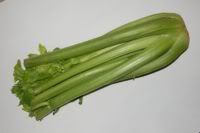
Celery is a good food for rabbits. Stalk celery is pleasantly leafy, well tolerated, and can be fed with all parts of the plant. It is ideal for rabbits with sensitive or sick digestion or as a leafy winter food.
Acceptance: good

Cauliflower (all colors, e.g. white, purple, yellow)
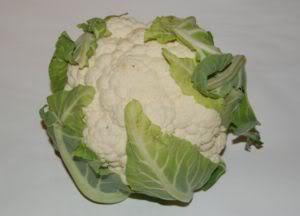
Cauliflower is very popular with rabbits and is also healthy. Since it is a type of cabbage, it should be introduced slowly into their diet, after which it can be offered as a supplement. The cauliflower leaves and stems can also be fed. However, cabbage is not suitable for rabbits that are fed commercial dry food.
Acceptance: very good
Calcium-Phosphorus ratio: 0.4

Cauliflower leaves
Cauliflower leaves are a good food for rabbits. Since they belong to the cabbage family, they should be introduced slowly into the diet, after which they can be offered as a supplement. The cauliflower leaves and stem can also be fed. However, cabbage is not suitable for rabbits that are fed commercial dry food.

Beans
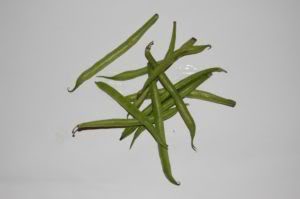
Beans can occasionally be fed in small amounts as part of a varied, dry food-free diet. They are not considered proper „rabbit food.“
Acceptance: poor
Calcium-to-phosphorus ratio: 1.5

Kale
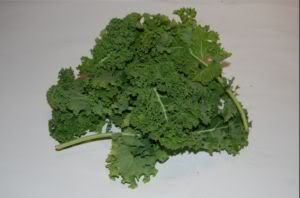
Kale is an ideal, leafy winter food. Since it’s a type of cabbage, it should always be introduced gradually. Only rabbits that are fed commercial dry food may find cabbage difficult to digest. Kale is extremely energy-dense and should not be offered in excess, particularly in indoor housing, even if they love it. In cases of overweight rabbits, it should only be given in small amounts for „foraging“ exercises. Due to its high energy content, overfeeding can lead to cecal problems (mushy stool, dirty rear end).
Acceptance: very good

Broccoli
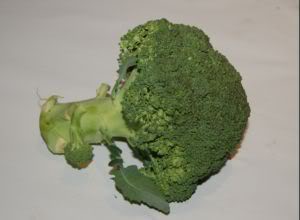
Broccoli is very popular and is one of the most well-tolerated cabbage varieties. Since it’s a type of cabbage, it should always be introduced gradually, after which it can be fed in larger amounts. Only rabbits that are fed commercial dry food may find cabbage intolerable.
Acceptance: very good
Calcium-to-phosphorus ratio: 0.9

Castel Franco
Castel Franco belongs to the bitter lettuce family and can be fed very well to rabbits. It is an ideal, leafy food option. Due to its bitter compounds, it is very well tolerated and is even ideal for rabbits with sensitive or ill digestive systems.
Acceptance: very good
Calcium-to-phosphorus ratio: 1.5

Champignon mushrooms
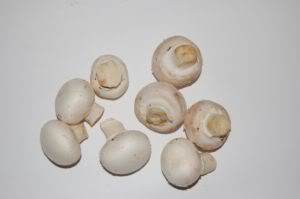
Mushrooms are generally controversial as a food for rabbits. Either they are not fed at all, or only occasionally in very small amounts.
Acceptance: poor
Calcium-to-phosphorus ratio: 0.1

Chicory (all varieties)
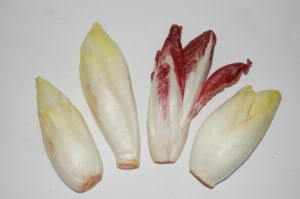
Chicory can be fed very well to rabbits. The outer leaves contain a relatively high amount of oxalic acid, so it’s best to avoid giving them in large quantities. Chicory is an ideal, leafy food option. Due to its bitter compounds, it is highly digestible and also ideal for rabbits with sensitive or ill digestive systems.
Acceptance: good
Calcium-to-phosphorus ratio: 1.0

Chili peppers

Chili is quite spicy, and therefore, it’s often advised against feeding it to rabbits. Spicy vegetables can occasionally be offered in very small amounts, but only if the rabbits are fed a varied diet and are willing to eat the chili. The capsaicin it contains has various health benefits, such as fighting tumors, stimulating the heart muscle in heart conditions, and reducing joint pain and weight issues.
Acceptance: poor
Calcium-to-phosphorus ratio: 0.4

Chinese cabbage
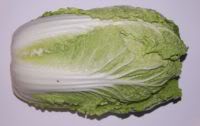
Chinese cabbage is well tolerated and can be fed in large amounts. Introduce it gradually! Only rabbits that are fed commercial dry food may find cabbage intolerable.
Acceptance: good
Calcium-to-phosphorus ratio: 1.3

Oak leaf lettuce (either red or green)
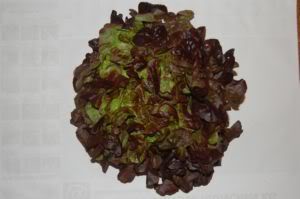
Oak leaf lettuce can be fed well to rabbits. The outer leaves are often contaminated with pesticides and fertilizers, so it’s a good idea to remove them before feeding.
Acceptance: good
Calcium-to-phosphorus ratio: 1.2

Iceberg lettuce
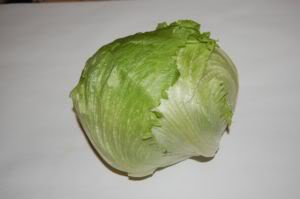
Iceberg lettuce can be fed to rabbits. The outer leaves are often contaminated with pesticides and fertilizers, so it’s best to remove them before feeding. Generally, iceberg lettuce has a low concentration of nutrients and should only make up a small portion of the diet.
Acceptance: good
Calcium-to-phosphorus ratio: 1.1

Endive
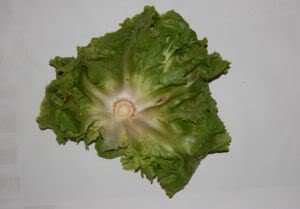
Endive is very well suited for feeding rabbits. It contains a high concentration of bitter compounds that help stabilize digestion. Due to its leafy structure, endive is an ideal main component of the diet.
Acceptance: good
Calcium-to-phosphorus ratio: 1.0

Pea pods
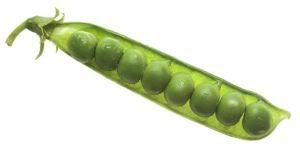
Pea pods can be fed as part of a varied, dry-food-free diet, provided they are offered in a good mix with other vegetables. However, they are not considered „rabbit food“ in the strict sense.
Acceptance: poor
Calcium-to-phosphorus ratio: 0.3

Field salad
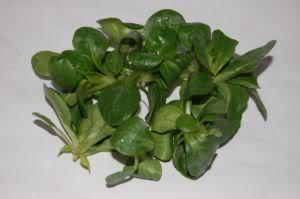
Field salad can be fed very well to rabbits. It is a classic winter salad.
Acceptance: good to poor
Calcium-to-phosphorus ratio: 0.7

Fennel (bulb)
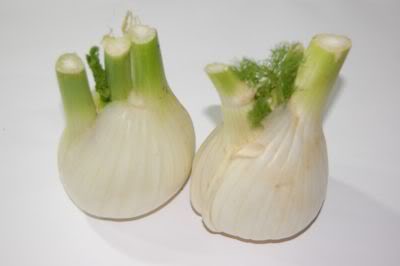
Fennel is very well-suited for feeding rabbits. Due to its essential oils, it has a positive effect on the digestive tract, especially in cases of digestive issues. It’s also ideal for introducing vegetables and is very well tolerated. Fennel can cause red urine (which is harmless). The fennel fronds are incredibly popular and can be fed in large amounts. The bulb is a good supplementary food. However, caution is needed as fennel is very energy-dense, so it is not suitable for overweight rabbits.
Acceptance: very good
Calcium-to-phosphorus ratio: 0.8

Frisée lettuce
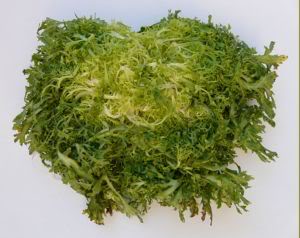
Frisée lettuce can be fed to rabbits. Its bitter compounds are beneficial for digestion. The outer leaves are often contaminated with pesticides and fertilizers, so it’s best to remove them before feeding.
Acceptance: good
Calcium-to-phosphorus ratio: 1.0

Spring onion
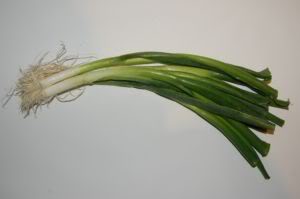
Spring onions are spicy, which is why they are often not recommended for feeding. However, spicy vegetables can be offered occasionally in very small amounts, as long as rabbits are given a varied diet. In case of illness, spring onions have antibacterial effects in the body, lower blood pressure, blood lipid levels, and blood sugar. Studies have also confirmed their blood-thinning and anti-asthmatic properties. For this reason, rabbits usually select onion plants as needed.
Acceptance: Poor
Calcium-to-phosphorus ratio: 1.3

Maize leaves
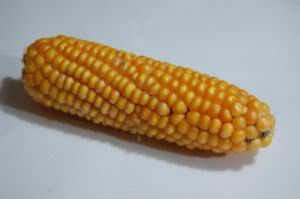
Forage corn is quite high in starch, making it an energy-rich rabbit feed (concentrated feed). It should be avoided in overweight rabbits. In autumn, unripe, fresh corn can be offered seasonally, but feeding dried kernels is not recommended due to their high starch content and potential damage to the teeth. The leaves of the plant are suitable for feeding, but since they are often heavily sprayed with pesticides, they should only be given once the plant has reached a certain height. Lower-growing plants often still contain harmful pesticides.
Acceptance: Very good

Yellow beet
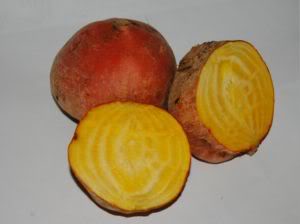
Yellow beet is a suitable feed and well tolerated by rabbits. However, it should be fed as part of a mix due to its oxalic acid content. Some rabbits may react with diarrhea, so it is best to introduce it gradually and monitor their digestion.
Acceptance: Very good
Calcium-to-phosphorus ratio: 0.6

Fodder Beet
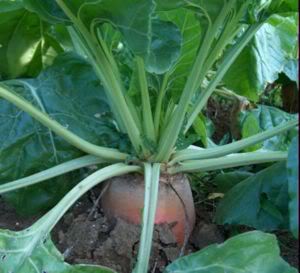
Fodder beets are suitable for feeding in small amounts. In autumn, they can be stored for the winter, providing a cost-effective feed option during the colder months. As with other root vegetables, they should be introduced gradually to avoid digestive issues.
Acceptance: Very good

Kale (Curly Kale)
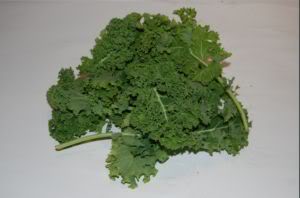
Kale (Curly Kale) is an ideal, leafy winter feed. Since it is a member of the cabbage family, it should always be introduced gradually. Only rabbits that are fed commercial dry food should avoid cabbage, as it can be intolerable for them. Kale is extremely energy-rich and should therefore not be offered in excess, even if rabbits love it. For overweight rabbits, it is allowed only in small amounts to be „earned“ through activity.
Acceptance: Very good
Calcium-to-phosphorus ratio: 2.4

Cucumber
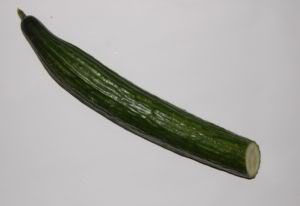
Cucumber is suitable in small amounts. When offered in large quantities without gradual introduction, it can lead to soft stool (mushy poops).
Acceptance: Poor to good
Calcium-to-phosphorus ratio: 1.0

Autumn Turnip
Autumn turnips can be fed to rabbits. They are well-tolerated when offered in moderation.
Acceptance: Good

Ginger (root)
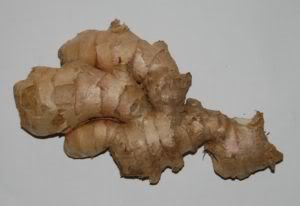
Ginger is very spicy for rabbits. It contains beneficial compounds and is especially effective for rabbits with weakened immune systems, inflammation, pus buildup, rabbit cold, and joint issues. Since it is not commonly eaten, it can be grated and mixed with banana or apple to increase acceptance when offered during illness.
Acceptance: Poor
Calcium-to-phosphorus ratio: 0.7

Jerusalem Artichoke
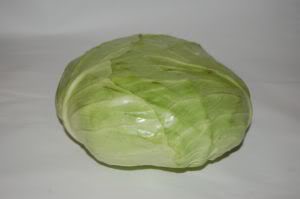
Jerusalem artichoke can be fed well to rabbits and is a leafy feed. Since it belongs to the cabbage family, it should always be introduced gradually, after which it can be offered in larger quantities. Removing the outer leaves helps minimize exposure to harmful substances. It should not be fed in combination with dry food.
Acceptance: Good
Calcium-to-phosphorus ratio: Likely around 1.2-1.7

Kai-Lan (Chinese Broccoli)
Kai-Lan is available in Asian supermarkets and is a great leafy feed for rabbits. Since it is a member of the cabbage family, it should be introduced gradually, after which it can be fed in larger quantities. It is best not to feed cabbage in combination with dry food.
Acceptance: Good

Cress (Lepidium sativum) / Hare’s Lettuce (Lactuca saligna)
Ideal food for rabbits, also in larger quantities.
Acceptance: Good

Carrot
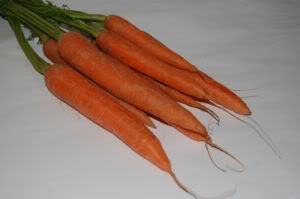
Carrots are liked by most rabbits and are well tolerated. They can also be used effectively to introduce vegetables into a rabbit’s diet. Carrots may cause red urine (which is harmless). However, a diet with a very high carrot content is not recommended, as rabbits should primarily eat leafy greens. Carrots should be considered a small supplement to their diet.
Acceptance: Very good
Calcium-to-phosphorus ratio: 1.1

Carrot Greens
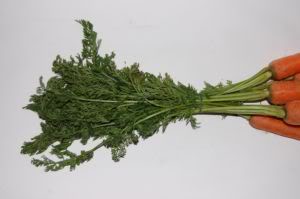
Carrot greens are a very appropriate, herbaceous feed for rabbits. Contrary to common belief, fresh carrot greens do not lead to bladder sludge. They have a lower calcium content than hay. However, carrot greens are very energy-rich, so they should be fed sparingly to overweight rabbits.
Acceptance: Very good
Calcium-to-phosphorus ratio: Approx. 3
P

Potato
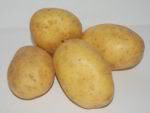
Potatoes have a high starch content (concentrated feed), and in their raw form, they are difficult to digest. Some rabbit owners offer cooked potatoes occasionally during winter outdoor housing, but cooked foods are generally not recommended as regular rabbit food (too heavily processed for rabbits). However, cooked potatoes can be helpful for weight gain in cases of energy deficiency or for nursing rabbits. They should never be fed during digestive issues. In small amounts, raw potatoes can be occasionally offered. The potato plant itself, including green parts and shoots, is very high in solanine and should only be fed in very small amounts, as part of a very varied and dry-food-free diet, as they can be toxic!
Acceptance: Poor
Calcium-to-phosphorus ratio: 0.1

Kiwano (Horned Melon)
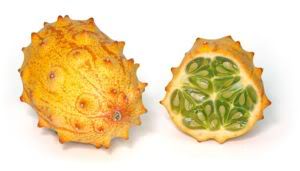
Horned melons belong to the squash family and can be offered as a supplementary food. However, if fed in excess and without gradual introduction, they can cause soft stools.
Acceptance: Poor to good
Calcium-to-phosphorus ratio: 0.8

Garlic
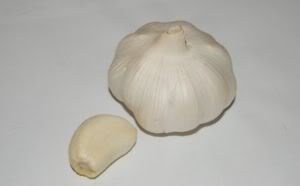
Garlic is very spicy and is rarely eaten by rabbits. Spicy vegetables can occasionally be offered in very small amounts, as long as the rabbits are fed a varied diet. In small quantities, garlic has health-promoting properties. However, due to its strong taste and potential toxicity, it should be used with caution.
Acceptance: Poor
Calcium-to-phosphorus ratio: 0.2

Celeriac
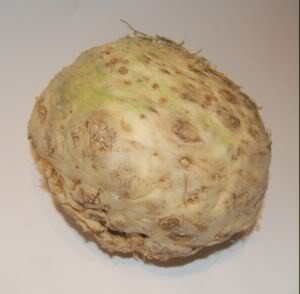
Celeriac is a good feed for rabbits and is well-suited for winter feeding. It is very well tolerated and can be fed in its entirety, including the root and stalks.
Acceptance: Good
Calcium-to-phosphorus ratio: 0.7

Celeriac Greens
Celeriac greens are a high-quality feed for rabbits and can be given in large quantities. They are nutritious, rich in fiber, and well-tolerated by most rabbits.
Acceptance: Very good
Calcium-to-phosphorus ratio: Not specified

Kohlrabi

Kohlrabi is eaten by rabbits, and its leaves are very popular and can be offered as well. Since it is a member of the cabbage family, it should be introduced gradually to avoid digestive issues. Once accustomed, it can be given in larger quantities. However, cabbage is not suitable for rabbits that are fed commercial dry food.
Acceptance: Kohlrabi bulb: Poor to good
Calcium-to-phosphorus ratio: 1.3

Kohlrabi leaves
Kohlrabi leaves are very popular and healthy. Since kohlrabi is a type of cabbage, they should always be introduced gradually. This way, they can be served in large quantities. However, for rabbits that are fed commercial dry food, cabbage is not suitable due to its potential for causing digestive issues. Kohlrabi leaves are high in energy, so they should only be given in small amounts to overweight rabbits, and these should be earned through activity.
Acceptance: very good
Calcium-to-phosphorus ratio: 1.2

Flower sprouts
It is a cross between Brussels sprouts and kale. Since it is a type of cabbage, it should always be introduced gradually, and then it can be served in large quantities. However, for rabbits that are fed commercial dry food, cabbage is unsuitable.
Acceptance: very good
Calcium-to-phosphorus ratio: –

Lettuce (green and red)
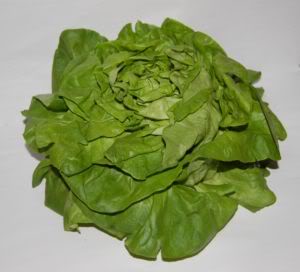
Lettuce can be offered. The outer leaves are often contaminated with pesticides and fertilizers, so it’s best to remove them before feeding. Overall, lettuce is a low-nutrient leafy green.
Acceptance: good
Calcium-to-phosphorus ratio: 0.9

Curly lettuce (Lollo Rosso – red, Lollo Bionda – green)
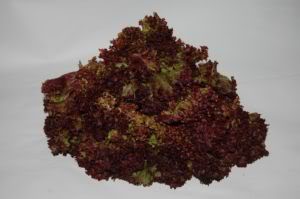
Curly lettuce is also a good food option. The outer leaves are often contaminated with pesticides and fertilizers, so it’s advisable to remove them before feeding.
Acceptance: good
Calcium-to-phosphorus ratio: 1.1

Pumpkin
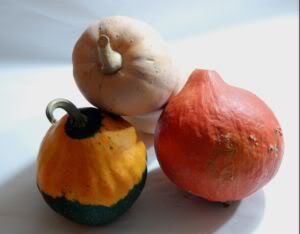
Pumpkin can be fed to rabbits, but they typically consume it in small amounts. There are no toxic varieties of pumpkin (decorative pumpkins are simply inedible), so there’s no risk of feeding the wrong kind. Pumpkins are also easy to obtain in the fall for winter feeding.
Acceptance: poor
Calcium-to-phosphorus ratio: 0.5

Turmeric
As a medicinal plant, turmeric has anti-inflammatory properties, among other benefits. However, due to its poor acceptance by rabbits, it should be mixed into their favorite foods to encourage consumption.
Acceptance: poor
Calcium-to-phosphorus ratio: 0.7

Leeks (Porree)
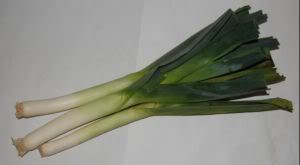
Leeks are quite sharp for rabbits and are usually not eaten in large amounts. Spicy vegetables can occasionally be offered in very small quantities, as long as the rabbit’s diet is varied. In cases of illness, spring onions, including leeks, have antibacterial properties, and they can help lower blood pressure, blood fat levels, and blood sugar. Some studies have even confirmed blood-thinning and anti-asthmatic effects. Therefore, onion family vegetables are often offered selectively based on the rabbit’s needs.
Acceptance: poor
Calcium-to-phosphorus ratio: 5.8

Spring onions
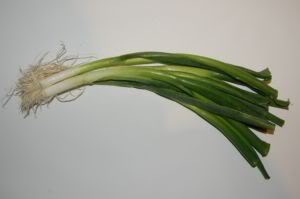
Spring onions are very sharp in flavor and are poorly accepted by rabbits. Spicy vegetables can be offered occasionally in very small amounts, provided the rabbit’s diet is varied. In cases of illness, spring onions have antibacterial properties and can help lower blood pressure, blood fat levels, and blood sugar. Studies have also confirmed blood-thinning and anti-asthmatic effects. As a result, onion family vegetables are typically offered based on the rabbit’s needs.
Acceptance: poor

Dandelion greens (Catalogna, also known as leaf chicory)
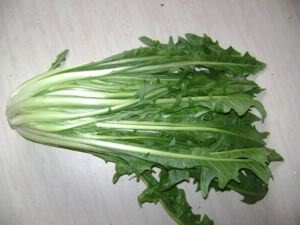
Dandelion salad (Catalogna, or leaf chicory) can be found in Turkish shops, and if it’s out of stock, it can usually be ordered. It’s a great vegetable for city dwellers or for winter feeding. Dandelion salad is ideal as a main component of a rabbit’s diet. While it is a bitter salad, it is very healthy for digestion. Despite its name, it is not related to common dandelion but is actually a variety of chicory.
Acceptance: very good
Calcium-to-phosphorus ratio: 2.6

Turnip
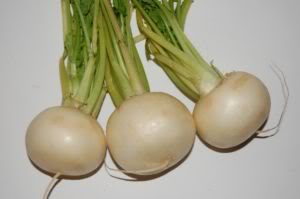
Spring turnips (Mairüben) can be fed along with the popular greens. The turnips themselves are considered supplemental food, while the greens can be given in larger quantities.
Acceptance: good
Calcium-to-phosphorus ratio: 1.6

Chard (all colors)
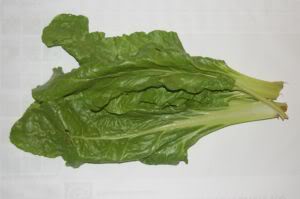
Chard has a relatively high oxalic acid content, so it should be offered only as part of a good mix with other vegetables or grasses. However, it also contains bitter compounds and has a favorable calcium-to-phosphorus ratio.
Acceptance: good (though rabbits tend to prefer the leaf edges, not the white stems)
Calcium-to-phosphorus ratio: 2.6

Mizuna
Mizuna is a rare type of leaf cabbage. It can be fed in large quantities once the rabbit has been gradually introduced to it and is generally well-tolerated. However, cabbage is unsuitable for rabbits that are fed commercial dry food.
Acceptance: rather poor
Calcium-to-phosphorus ratio: 3.3

Horseradish
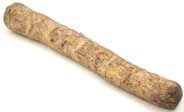
Horseradish is very sharp for a rabbit’s stomach. Spicy vegetables can be offered occasionally in very small amounts, provided the rabbit’s diet is varied. Horseradish has healing properties for inflammation of the bladder, kidneys, urinary tract, respiratory system (such as colds), and lungs. It also has mucolytic (helps with mucus) and anti-inflammatory effects. Due to its poor acceptance, it can be mixed with a favorite food when offered during illness.
Acceptance: poor
Calcium-to-phosphorus ratio: 1.1

Carrot
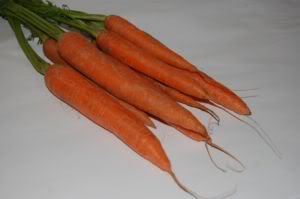
Carrots are liked by most rabbits and are well tolerated. They can also be used to introduce vegetables into their diet. Carrots may cause red-colored urine, which is harmless. However, a diet with a very high proportion of carrots is not recommended, as rabbits should primarily eat leafy greens as their main food source. Carrots should only be given as a small supplement.
Acceptance: very good
Calcium-to-phosphorus ratio: 1.1

Carrot greens
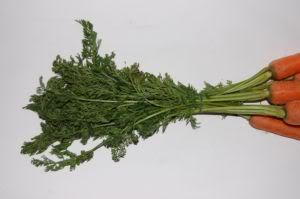
Carrot greens are a very species-appropriate food. Contrary to widespread belief, feeding them fresh does not lead to bladder sludge. They have a lower calcium content than hay. Carrot greens are very energy-dense and should therefore be fed in very small amounts to rabbits that are overweight.
Acceptance: very good
Calcium-to-phosphorus ratio: approx. 3.0

Navette, also known as rutabaga or swede
Spring turnip with a pinkish hue.
Acceptance: very good
Calcium-to-phosphorus ratio: 1.7

Olives
Olives from the jar are preserved in oil or other unhealthy substances, making them unsuitable as food for rabbits. Fresh olives can be fed occasionally in small amounts. Due to their high fat content, they are considered an energy-dense food.
Acceptance: good
Calcium-to-phosphorus ratio: –

Pak Choi
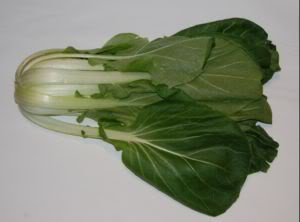
Pak Choi (also known as mustard greens or leaf cabbage) is related to Chinese cabbage and originates from Asia. It can be offered to rabbits and is a good food option.
Acceptance: good
Calcium-to-phosphorus ratio: 1.3

Black Kale or Cavolo Nero
Black kale (Palmkohl) is a healthy food option. It can be fed in large amounts once the rabbit has been gradually introduced to it and is generally well-tolerated. However, cabbage is unsuitable for rabbits that are fed commercial dry food.
Acceptance: very good
Calcium-to-phosphorus ratio: 2.4

Puntarelle
A form of chicory, very rich in bitter compounds. It closely resembles dandelion salad (Catalogna).
Acceptance: very good
Calcium-to-phosphorus ratio: –

Bell peppers (all colors)
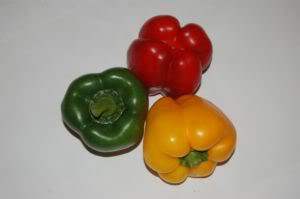
Bell peppers can be offered, but they are usually eaten in small amounts. Some rabbits, however, enjoy them. The white inner tissue and seeds are particularly popular. The green part of the stem contains a lot of solanine. With a varied diet, it can be occasionally fed in very small amounts.
Acceptance: poor to good
Calcium-to-phosphorus ratio: 0.3

Parsnip
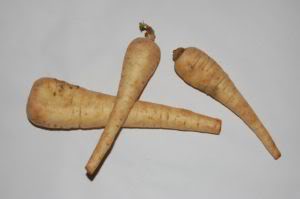
Parsnips can be fed in small amounts and are well tolerated. They promote digestive health. Caution: Parsnips are energy-dense and therefore unsuitable for overweight rabbits.
Acceptance: very good
Calcium-to-phosphorus ratio: 0.7

Parsley root
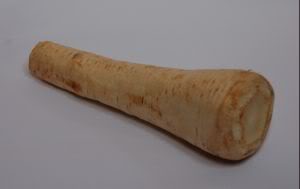
Parsley root can be offered in small amounts. It is good for promoting healthy digestion. However, caution: it is extremely energy-dense and should be avoided for overweight rabbits.
Acceptance: very good
Calcium-to-phosphorus ratio: 0.7

Mushrooms (all edible varieties)
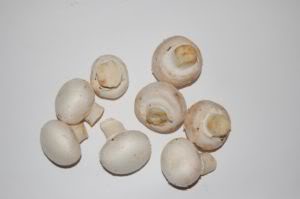
Mushrooms are generally controversial as a food for rabbits. They should either not be fed at all or only in very small amounts. Rabbits don’t particularly like them and usually leave them uneaten.
Acceptance: poor
Calcium-to-phosphorus ratio: approx. 0.1

Portulak
Ideal food, even in large amounts.
Acceptance: good
Calcium-to-phosphorus ratio: 1.5

Postelein
It is often referred to as winter purslane, but it is not the same as purslane. A very good winter salad.
Acceptance: very good
Calcium-to-phosphorus ratio: 2.7

Radicchio, Radicchio Trevisano, Radicchio Rosso di Treviso, Radicchio pink
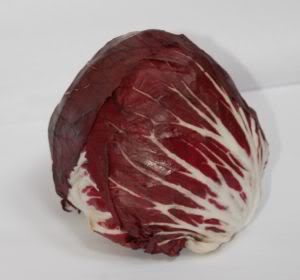
Radicchio is not a type of cabbage but a bitter lettuce and can be fed very well. The outer leaves are often contaminated with pesticides and fertilizers, so they should be removed before feeding. Radicchio is an excellent food. Due to its bitter compounds, it is very well tolerated and ideal for rabbits with sensitive or sick digestive systems.
Acceptance: good to very good
Calcium-to-phosphorus ratio: 1.5

Radishes
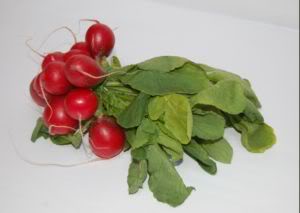
Radishes are spicy and therefore suitable for feeding only in small amounts.
Acceptance: poor to good
Calcium-to-phosphorus ratio: 1.4

Radish greens

Radish greens are very popular and can be fed in large amounts.
Acceptance: very good
Calcium-to-phosphorus ratio: approx. 6

Radish (white, red, black)
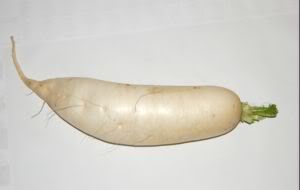
Radish is quite spicy. Spicy vegetables can be offered in very small amounts occasionally, as long as the rabbit’s diet is varied. The leaves are very popular and can also be fed. Radish has strong anti-inflammatory properties, especially for the respiratory and urinary tracts.
Acceptance: poor. Radish greens: very good.
Calcium-to-phosphorus ratio: 1.3
Calcium-to-phosphorus ratio for radish greens: approx. 6.7

Rhubarb
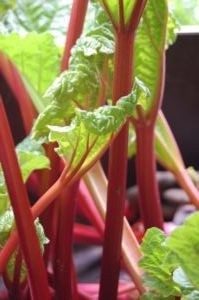
Rhubarb is often mistakenly labeled as toxic. In small amounts, when part of a good mix of food plants, it is usually fine (Caution: high oxalic acid content!).
Acceptance: poor
Calcium-to-phosphorus ratio: 6.1

Romaine lettuce
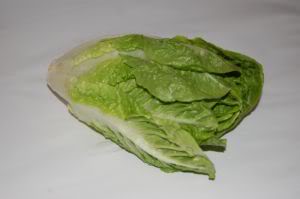
Romaine is a well-suited food lettuce. The outer leaves are often contaminated with pesticides and fertilizers, so they should be removed before feeding.
Acceptance: good
Calcium-to-phosphorus ratio: 0.8

Romanesco
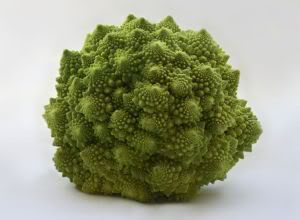
Romanesco is a type of brassica, specifically a variety of cauliflower. After gradual introduction, it can also be fed in larger quantities. However, cabbage is unsuitable for rabbits that are fed commercial dry food.
Acceptance: very good
Calcium-to-phosphorus ratio: 0.5

Brussels sprouts
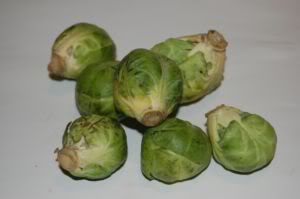
Brussels sprouts can be fed well and are gladly eaten. Since they belong to the cabbage family, they should always be introduced gradually. Removing the outer leaves helps reduce potential contaminants. However, cabbage is unsuitable for rabbits that are fed commercial dry food. Brussels sprouts are quite high in energy and should only be given in small amounts if the rabbit is overweight.
Acceptance: good
Calcium-to-phosphorus ratio: 0.4

Red beet (beetroot) or also striped and pink beet
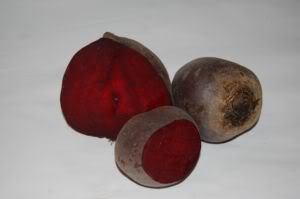
Red beet (beetroot) has a high oxalic acid content and should always be fed as part of a mix with other vegetables. It can cause the urine and feces to turn red, which is harmless. Some rabbits may develop diarrhea from eating beetroot. The leaves are also suitable for feeding. Beetroot is extremely high in energy and should be avoided for overweight rabbits.
Acceptance: very good
Calcium-to-phosphorus ratio: 0.6

Red cabbage“ (also known as „blue kraut“
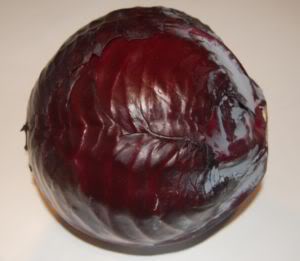
Red cabbage can be offered and is considered a leafy vegetable. Since it belongs to the cabbage family, it should always be introduced gradually. Removing the outer leaves helps reduce potential contaminants. However, cabbage is unsuitable for rabbits that are fed commercial dry food.
Acceptance: poor
Calcium-to-phosphorus ratio: 1.1

Arugula (rocket)
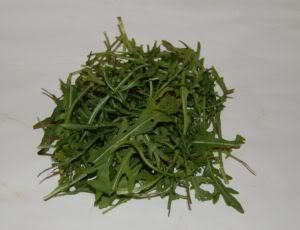
Arugula has a slightly spicy taste and belongs to the cabbage family. It can also be fed in large quantities and is generally well tolerated. However, for rabbits that are fed commercial dry food, cabbage is not suitable. In our experience, many rabbits do not tolerate it well, especially when it comes from the supermarket and has been stored in plastic for an extended period.
Acceptance: very good
Calcium-phosphorus ratio: 3.3

SalaRico
It is a relatively new type of lettuce that rabbits can eat. It is a cross between Romaine lettuce and Iceberg lettuce. In general, SalaRico is a lettuce with a low concentration of active ingredients.
Acceptance: good

Cucumber (Snake cucumber)
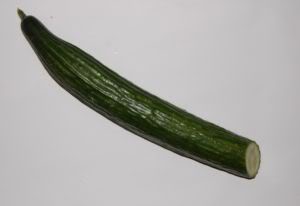
Cucumber is suitable for rabbits. However, if offered in large amounts without a gradual introduction, it can lead to soft stool (mushy poop).
Acceptance: poor to good

Black kale (Palm kale, Italian kale, Tuscan kale)
Black kale is a healthy food option. It can be fed once gradually introduced and is generally well tolerated. However, for rabbits that are fed commercial dry food, cabbage is not suitable. Black kale is extremely energy-dense and should only be offered in small amounts, which should be earned, for overweight rabbits.
Acceptance: very good
Calcium-phosphorus ratio: 2.4

Salsify (Oyster plant, or Winter asparagus)
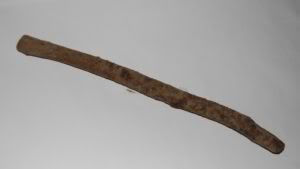
Salsify is rarely touched but is suitable as food if the rabbits eat it.
Acceptance: poor
Calcium-phosphorus ratio: 0.7

Shallots
Shallots are very spicy. Spicy vegetables can be offered in very small amounts occasionally, as long as the rabbits are fed a varied diet.
Acceptance: poor
Calcium-phosphorus ratio: 0.6

Celery (Celeriac or stalk/bleached celery)
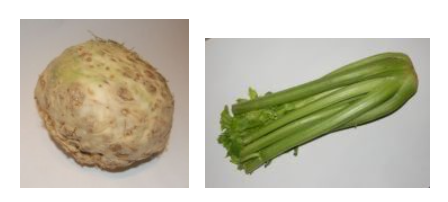
Celery is a good feed. The stalk celery is pleasantly leafy, while the celeriac (root celery) is suitable in small quantities for winter feeding. Both are very well tolerated and can be fed in their entirety.
Acceptance: good
Calcium-phosphorus ratio: 0.7 (celeriac), 1.7 (stalk celery)

Asparagus
Asparagus can be offered regularly if it is eaten.
Acceptance: poor
Calcium-phosphorus ratio: 0.6

Spinach
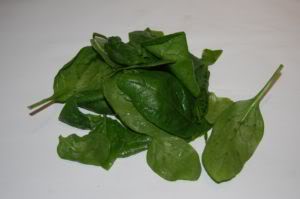
Leaf spinach is a nicely leafy feed. However, due to its high oxalic acid content, it should always be offered in a good mixture with other vegetables or meadow plants.
Acceptance: good
Calcium-phosphorus ratio: 2.7

Pointed cabbage
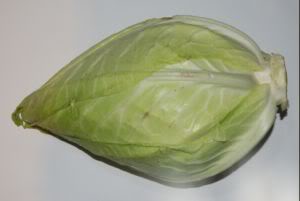
Pointed cabbage is suitable for feeding. Since it is a cabbage variety, it should always be introduced slowly. Removing the outer leaves helps minimize the pollutant load.
Acceptance: very good
Calcium-phosphorus ratio: 1.7

Stem cabbage (Brassica rapa var. cymosa, Cima di Rapa)
Ideal feed, can be given in larger quantities.
Acceptance: good
Calcium-phosphorus ratio: 1.4

Stalk celery (blanched celery)
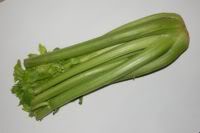
Celery is a good feed. Stalk celery is pleasantly leafy and is gladly eaten. It is very well tolerated and can be fed with all parts of the plant.
Acceptance: good
Calcium-phosphorus ratio: 1.7

Rutabaga (Swede)
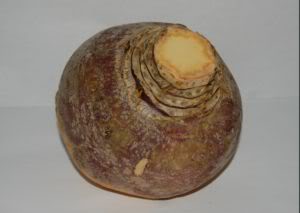
Rutabagas are well-suited for feeding and are also well-tolerated.
Acceptance: good
Calcium-Phosphorus ratio: 1.5

Stielmus (turnip tops)
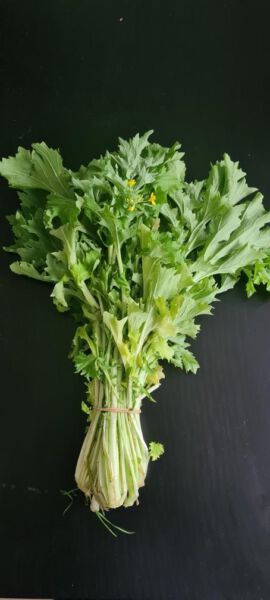
Ideal green fodder for rabbits, well-tolerated.
Acceptance: Very good
Calcium-Phosphorus ratio: 2.2

Sweet potato
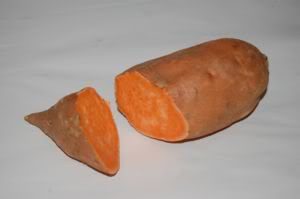
Sweet potatoes are a potential feed vegetable. Since they are very energy-rich (due to their starch content), they can be fed as a healthy concentrate feed. For animals that do not require concentrate feed, they should only be given in smaller amounts.
Acceptance: good
Calcium-Phosphorus ratio: 0.6

Tomato, cherry tomatoes, vine tomatoes, cocktail tomatoes, and others.
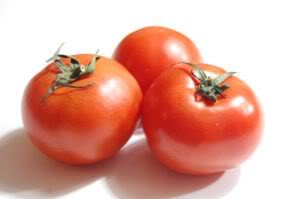
Tomatoes are very water-rich, so large amounts can lead to soft stool (mushy feces). However, the green parts at the plant’s base are quite high in solanine and should only be fed in small quantities as part of a very varied, dry-food-free diet, otherwise, they can be toxic.
Acceptance: poor to good
Calcium-Phosphorus ratio: 0.5

Claytonia (also known as miner’s lettuce or winter purslane)
It is often referred to as winter purslane, but it is not the same as purslane. A very good winter salad.
Acceptance: very good
Calcium-Phosphorus ratio: 2.7

Jerusalem artichoke
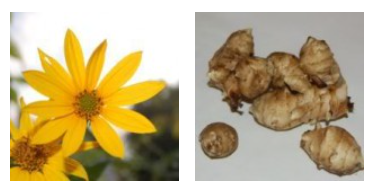
Jerusalem artichoke plants (and also flowers) grow incredibly fast and can be fed well. In autumn, the plants form tubers, which are also available in stores. These are suitable for feeding. They are quite energy-rich (high starch content) and are therefore suitable as a healthy concentrate feed in small amounts.
Acceptance: Leaves/plant: poor to good. Tubers: very good
Calcium-Phosphorus ratio (tubers): 0.1

White turnip (autumn turnip)
White turnips can be fed.
Acceptance: good
Calcium-Phosphorus ratio: 1.6

White cabbage
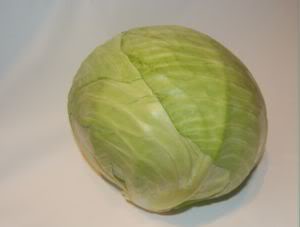
White cabbage is well-suited for feeding. Since it is a type of cabbage, it should always be introduced gradually. Removing the outer leaves helps minimize the pollutant load. Cabbage is only unsuitable for rabbits that are fed commercial dry food.
Acceptance: good
Calcium-Phosphorus ratio: 1.3

Savoy cabbage
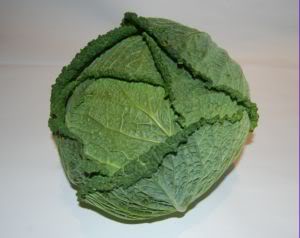
Savoy cabbage can be fed very well. Since it is a type of cabbage, it should always be introduced gradually, then it can be given in large amounts. Removing the outer leaves helps minimize the pollutant load. Cabbage is only unsuitable for rabbits that are fed commercial dry food.
Acceptance: very good
Calcium-Phosphorus ratio: 1.1

Zucchini
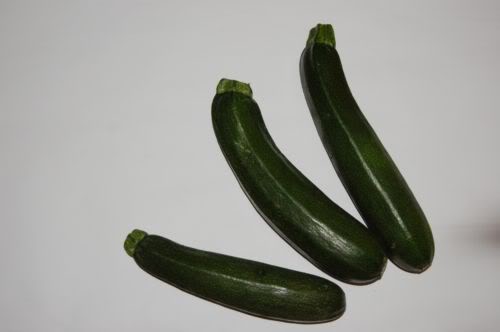
Zucchini can be offered.
Acceptance: poor
Calcium-Phosphorus ratio: 1.2

Sugarloaf (chicory salad)
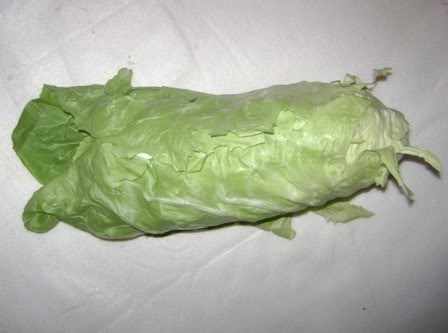
Sugarloaf is well-suited as rabbit food and can be fed regularly. Removing the outer leaves helps minimize the pollutant load. Due to its bitter compounds, it is very well tolerated and also ideal for rabbits with sick or sensitive digestion.
Acceptance: good
Calcium-Phosphorus ratio: 1.2

Sweet corn (cob)
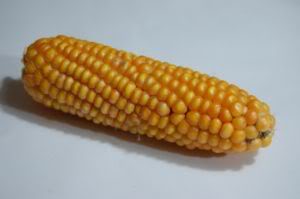
Sweet corn is quite rich in starch and sugar, making it an energy-dense rabbit food (concentrate feed). It can be offered occasionally in the fall, but I would advise against feeding it in large quantities over an extended period due to its high starch content. The leaves of the plant are suitable for feeding. Dried corn is extremely hard and can be harmful to teeth!
Acceptance: very good
Calcium-Phosphorus ratio: 0.0

Sugar beets
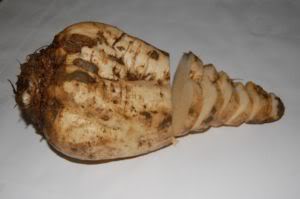
Sugar beets are relatively high in sugar. They can be fed regularly in treat-sized amounts by hand.
Acceptance: good to very good

Onions
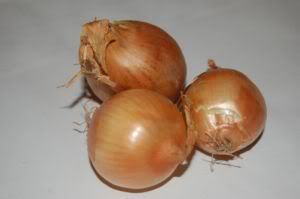
Onions are very sharp and should not be touched. Spicy vegetables can be offered in very small amounts occasionally, provided you feed your rabbits a varied diet.
Acceptance: poor Calcium-phosphorus ratio: 0.9




